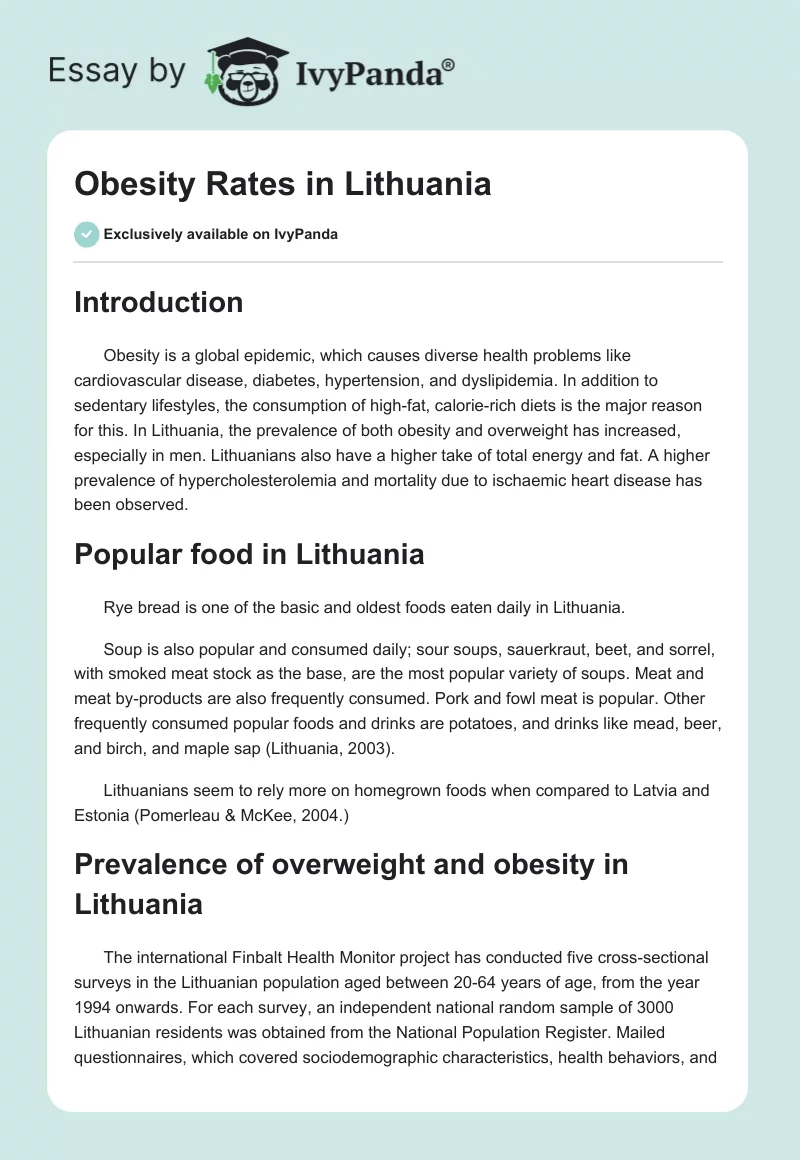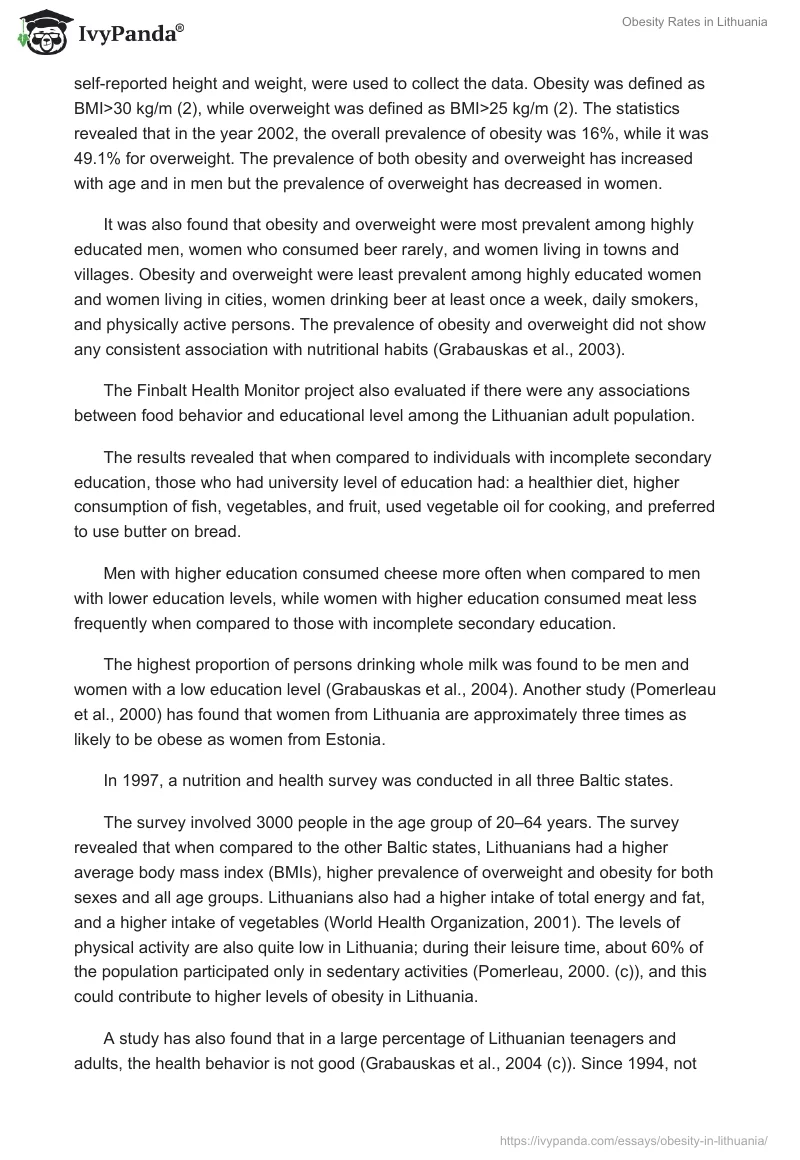Introduction
Obesity is a global epidemic, which causes diverse health problems like cardiovascular disease, diabetes, hypertension, and dyslipidemia. In addition to sedentary lifestyles, the consumption of high-fat, calorie-rich diets is the major reason for this. In Lithuania, the prevalence of both obesity and overweight has increased, especially in men. Lithuanians also have a higher take of total energy and fat. A higher prevalence of hypercholesterolemia and mortality due to ischaemic heart disease has been observed.
Popular food in Lithuania
Rye bread is one of the basic and oldest foods eaten daily in Lithuania.
Soup is also popular and consumed daily; sour soups, sauerkraut, beet, and sorrel, with smoked meat stock as the base, are the most popular variety of soups. Meat and meat by-products are also frequently consumed. Pork and fowl meat is popular. Other frequently consumed popular foods and drinks are potatoes, and drinks like mead, beer, and birch, and maple sap (Lithuania, 2003).
Lithuanians seem to rely more on homegrown foods when compared to Latvia and Estonia (Pomerleau & McKee, 2004.)
Prevalence of overweight and obesity in Lithuania
The international Finbalt Health Monitor project has conducted five cross-sectional surveys in the Lithuanian population aged between 20-64 years of age, from the year 1994 onwards. For each survey, an independent national random sample of 3000 Lithuanian residents was obtained from the National Population Register. Mailed questionnaires, which covered sociodemographic characteristics, health behaviors, and self-reported height and weight, were used to collect the data. Obesity was defined as BMI>30 kg/m (2), while overweight was defined as BMI>25 kg/m (2). The statistics revealed that in the year 2002, the overall prevalence of obesity was 16%, while it was 49.1% for overweight. The prevalence of both obesity and overweight has increased with age and in men but the prevalence of overweight has decreased in women.
It was also found that obesity and overweight were most prevalent among highly educated men, women who consumed beer rarely, and women living in towns and villages. Obesity and overweight were least prevalent among highly educated women and women living in cities, women drinking beer at least once a week, daily smokers, and physically active persons. The prevalence of obesity and overweight did not show any consistent association with nutritional habits (Grabauskas et al., 2003).
The Finbalt Health Monitor project also evaluated if there were any associations between food behavior and educational level among the Lithuanian adult population.
The results revealed that when compared to individuals with incomplete secondary education, those who had university level of education had: a healthier diet, higher consumption of fish, vegetables, and fruit, used vegetable oil for cooking, and preferred to use butter on bread.
Men with higher education consumed cheese more often when compared to men with lower education levels, while women with higher education consumed meat less frequently when compared to those with incomplete secondary education.
The highest proportion of persons drinking whole milk was found to be men and women with a low education level (Grabauskas et al., 2004). Another study (Pomerleau et al., 2000) has found that women from Lithuania are approximately three times as likely to be obese as women from Estonia.
In 1997, a nutrition and health survey was conducted in all three Baltic states.
The survey involved 3000 people in the age group of 20–64 years. The survey revealed that when compared to the other Baltic states, Lithuanians had a higher average body mass index (BMIs), higher prevalence of overweight and obesity for both sexes and all age groups. Lithuanians also had a higher intake of total energy and fat, and a higher intake of vegetables (World Health Organization, 2001). The levels of physical activity are also quite low in Lithuania; during their leisure time, about 60% of the population participated only in sedentary activities (Pomerleau, 2000. (c)), and this could contribute to higher levels of obesity in Lithuania.
A study has also found that in a large percentage of Lithuanian teenagers and adults, the health behavior is not good (Grabauskas et al., 2004 (c)). Since 1994, not only has the prevalence of smoking and alcohol increased amongst Lithuanian teenagers, aged 11-15 years and adult women but the consumption of fresh fruits has also declined (Grabauskas et al., 2004 (c)).
However, a study, which compared the prevalence of overweight and obesity in school-aged youth from 34 countries, found that Malta and the United States had the highest prevalence of overweight and obese youth while Lithuania and Latvia had the lowest prevalence (Janssen et al., 2005).
Influence of obesity and diet on health in Lithuania
Lithuanians have a high consumption of alcohol, and there is increased mortality due to ischemic heart disease, attributed especially to binge drinking of alcohol, on the weekends (Chenet et al., 2001).
The statistics on cardiovascular diseases reveal that about half of the total mortality rate, 30% of disabilities, and 15–20% of all referrals to health care institutions in Lithuania are due to cardiovascular diseases (World Health Organization, 2001). Data obtained from CINDI reveals that the prevalence of hypertension among the male population aged 25–64 is very high and it has hardly changed in the last ten years (World Health Organization, 2001).
A higher prevalence of hypercholesterolemia has been observed in both sexes between 1993 and 1999, and associated with increasing age, men with higher education, overweight individuals, smokers, and hypertensives (Grabauskas 2003 (d)).
There is a difference between the incidence of type 1 diabetes in the age group 0–39 years in urban and rural areas in Lithuania. The incidence is lower in the rural areas than in small towns and cities, and this difference is more in younger children.
It is unclear which lifestyle-associated factors may be responsible for the observed urban-rural differences of type 1 diabetes in Lithuania (Pundziute-Lyckå et al., 2003).
Conclusion
In Lithuania, statistics in the year 2002 showed that the overall prevalence of obesity was 16%, while it was 49.1% for overweight. The prevalence of both obesity and overweight has increased with age and in men but the prevalence of overweight has decreased in women. When compared to the other Baltic states, Lithuanians had a higher than average body mass index (BMIs), higher prevalence of overweight and obesity for both sexes and all age groups. Lithuanians also had a higher intake of total energy and fat; the levels of physical activity are also quite low in Lithuania. All these are important contributors to the high levels of obesity in Lithuania. There is increased mortality due to ischemic heart disease, high prevalence of hypertension, and hypercholesterolemia in Lithuania.
References
Chenet, L, Britton, A, Kalediene, R, Petrauskiene, J (2001).
Daily variations in deaths in Lithuania: the possible contribution of binge drinking. International Journal of Epidemiology. 30:743-748.
Grabauskas V, Petkeviciene J, Klumbiene J, Vaisvalavicius, V (2003). The prevalence of overweight and obesity in relation to social and behavioural factors (Lithuanian health behaviour monitoring). Medicina (Kaunas). 39(12): 1223-30.
Grabauskas, V, Petkeviciene, J, Kriaucioniene V, Klumbiene J (2004). Health inequalities in Lithuania: education and nutrition habits. Medicina (Kaunas). 40(9): 875-83.
Grabauskas V, Zaborskis A, Klumbiene J, Petkeviciene J, Zemaitiene N (2004. c). Changes in health behaviour of Lithuanian adolescents and adults over 1994-2002. Medicina (Kaunas). 40(9): 884-90.
Grabauskas, V, Miseviciene, I, Klumbiene, J, Petkeviciene, J, Milasauskiene, Z, Plieskiene, A, Margeviciene, L (2003. d.). Prevalence of dyslipidaemia among Lithuanian rural population (CINDI program). Medicina (Kaunas). 39(12): 1215-22.
Janssen, I, Katzmarzyk, PT, Boyce, WF, Vereecken, C, Mulvihill, C, Roberts, C, Currie, C,
Pickett, W (2005). Comparison of overweight and obesity prevalence in school-aged youth from 34 countries and their relationships with physical activity and dietary patterns. Obes Rev. 6(2): 123-32.
Pomerleau, J, Pudule, I, Grinberga, D, Kadziauskiene, K, Abaravicius, A, Bartkeviciute, R, Vaask, S, Robertson, A, McKee, M (2000). Patterns of body weight in the Baltic Republics. Public Health Nutr. 3(1): 3-10.
Pomerleau, J, McKee, M (2004). Nutrition and lifestyle in the Baltic Republics. Web.
Pomerleau, J, McKee, M, Robertson, A, Vaasc, S, Kadziauskiene, K, Abaravicius, A, Bartkeviciute, R, Pudule, I, Grinberga, D (2000. c). Physical inactivity in the Baltic countries. Prev Med. (6):665-72.
Pundziute-Lyckå, A, Urbonaite, B, Ostrauskas, R, Zalinkevicius, R, Dahlquist, GG (2003). Incidence of Type 1 Diabetes in Lithuanians Aged 0–39 Years Varies by the Urban-Rural Setting, and the Time Change Differs for Men and Women During 1991–2000. Diabetes Care 26:671-676.
World Health Organization (2001). Regional Office for Europe. Highlights on health in Lithuania.


